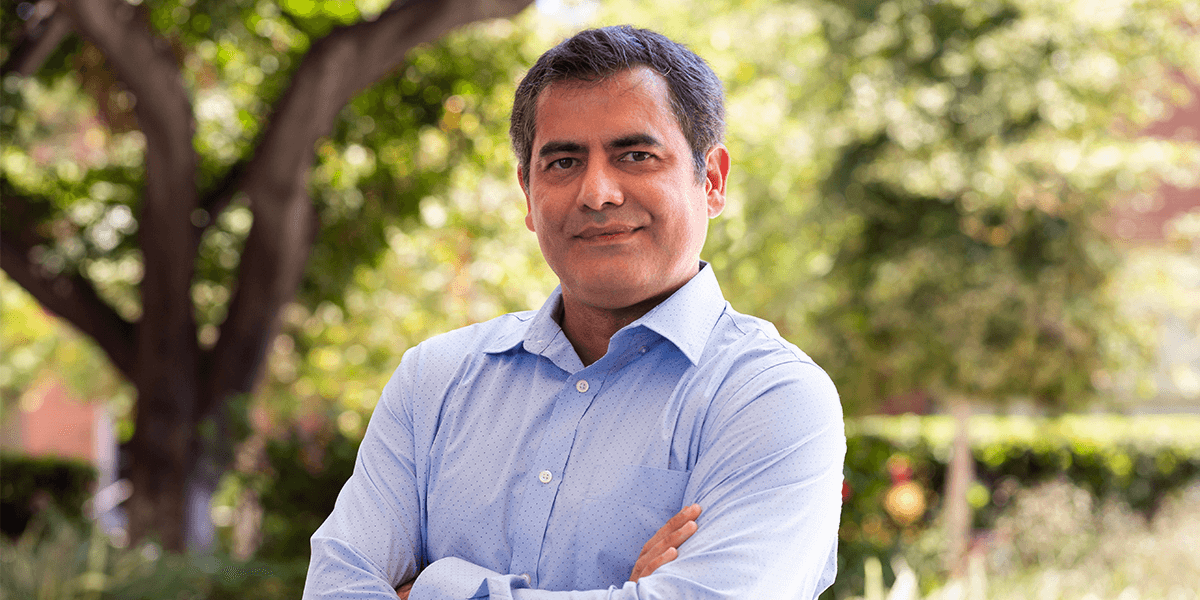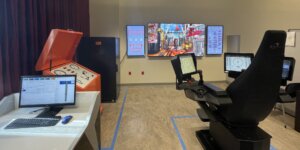
Energi Simulation Chair in Subsurface Energy Data Science Behnam Jafarpour. Image/Emilia Doda
As the world moves toward a sustainable energy future, it is critical to optimize how we manage the existing resources that lie under the earth’s surface, to enable a smooth energy transition to renewables. Harnessing data through AI and machine learning will be key to this endeavor.
To this end, Energi Simulation — a Canadian not-for-profit foundation — has committed CAD$540,000 (around USD$420,000) over three years to support a new Industrial Research Chair in Subsurface Energy Data Science at the USC Viterbi School of Engineering. The inaugural Energi Simulation Chair will be Professor of Chemical Engineering and Materials Science, Behnam Jafarpour, a leading data science and computational geoscience expert in the Mork Family Department of Chemical Engineering and Materials Science, who focuses on understanding, modeling, and controlling flow and transport in subsurface energy and environmental systems.
The funding support will enable a multidisciplinary research program at USC to capitalize on the exciting potential for AI and data science to transform the subsurface energy sector. In addition to Energi Simulation, the program will be supported by industry, government, and USC to develop state-of-the-art technologies informed by physics and data, to improve the recovery and management of subsurface energy resources, while minimizing the environmental footprint of energy development and utilization.
An Endowed Fellow at Viterbi, Jafarpour has an extensive background in subsurface modeling — from his early research focusing on modeling groundwater aquifers and petroleum reservoirs, to new research that harnesses physics-informed data analytics and AI for innovation in areas such as geologic CO2 storage, hydrocarbon resources and geothermal energy.
“The Subsurface Energy Data Science Chair will leverage AI, data revolution, and scientific computing to develop novel technologies for efficient modeling, simulation, imaging, and optimization of subsurface energy systems. I am excited about the new opportunities that lie ahead and I’m grateful to Energi Simulation for their continued support and partnership as we work together to realize this vision,” Jafarpour said.
The research program will focus on data science as an enabling technology. Ultimately, these new technologies will help to enhance recovery efficiencies from the subsurface resources and to mitigate the risks associated with their development.
“What we’ll be focusing on for the next three years and beyond is developing new data science tools that are tailored specifically for subsurface energy and environmental applications,” Jafarpour said.
The chair program will build on the strong foundation in both subsurface flow modeling and data science at USC Viterbi, to develop a center with a research team of 21 personnel, consisting of Jafarpour as the chair holder, an affiliated professor, a postdoctoral fellow, 12 Ph.D. students, four master’s students, and an administrative assistant. The chair program will also foster collaboration with Energi Simulation chairs at other institutions and will also see the establishment of a multi-sponsored joint industry project to enhance technology transfer to the energy industry. It is also envisioned to partner closely with the new Ershaghi Center for Energy Transition (E-CET) recently established at USC Viterbi.
Jafarpour said that the data science tools developed out of the new research program will contribute to improving efficiency in both energy recovery and environmental mitigation of energy utilization, in a world looking to move to clean and sustainable sources of energy.
A number of USC Viterbi researchers and leaders had been heavily involved in the development of the research program for subsurface energy data science, including Omar B. Milligan Chair in Petroleum Engineering, Iraj Ershaghi, and Executive Director of USC’s Energy Institute Donald Paul, also serving on the advisory committee that would continue to play a critical role as the chair program and associated center takes shape.
Ershaghi, Director of Petroleum Engineering at USC and a member of the US National Academy of Engineering said that Jafarpour ’s research in subsurface reservoir characterization was at the forefront of the petroleum engineering industry.
“His work is widely perceived as outstanding. He is amongst the topmost echelon of petroleum engineering academicians and researchers,” Ershaghi said. “We are very pleased for the support and recognition by Energi Simulation, and our continued partnership to further advance this exciting research area.”
Founded in 1978, Energi Simulation (formerly Foundation CMG) promotes and financially supports research and graduate students through research grants at universities. The organization’s mandate is to invest in leading-edge research and innovation in energy resource modeling. Energi Simulation partners with universities, governments, and industry sponsors to drive unique multi-year support of student education and world leading researchers at universities, in Europe, North America, South America, and the Asia-Pacific region.
President of Energi Simulation, Duke Anderson said: “We are thrilled that Professor Jafarpour will be continuing as an Energi Simulation industrial research chair – this time in Subsurface Energy Data Science. Our unique global network of simulation experts has made, and will continue to make, a difference in the energy transition.”
Published on July 20th, 2022
Last updated on July 21st, 2022













